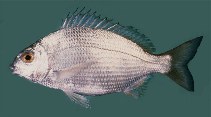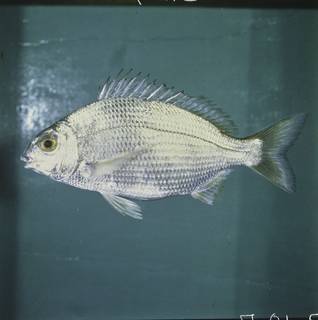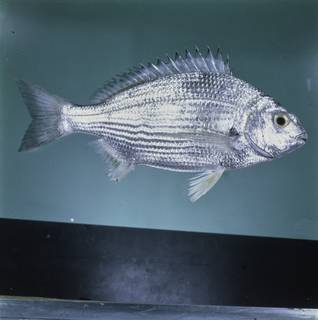WoRMS taxon details
Crenidens crenidens (Forsskål, 1775)
127048 (urn:lsid:marinespecies.org:taxname:127048)
accepted
Species
Crenidens forskali Valenciennes, 1830 · unaccepted > misspelling
Crenidens forskalii Valenciennes, 1830 · unaccepted (synonym)
Sparus crenidens Forsskål, 1775 · unaccepted
- Subspecies Crenidens crenidens indicus Day, 1873 accepted as Crenidens indicus Day, 1873
marine, brackish, fresh, terrestrial
(of Sparus crenidens Forsskål, 1775) Niebuhr, C. (1775). Descriptiones animalium avium, amphibiorum, piscium, insectorum, vermium; quae in itinere orientali observavit Petrus Forskål. <em>Post mortem auctoris edidit Carsten Niebuhr. Hauniae.</em> 1-20 + i-xxxiv + 1-164, map. [Pisces on pp. x-xix and 22-76]., available online at http://www.biodiversitylibrary.org/item/18564
page(s): xv [details]
page(s): xv [details]
Description Caught in shallow coastal waters, mainly in muddy quiet areas. In the northern part of the Indian Ocean, it is caught all...
Description Caught in shallow coastal waters, mainly in muddy quiet areas. In the northern part of the Indian Ocean, it is caught all year round and consumed fresh. In the southern part of the Indian Ocean, it is fished mainly for bait. Feeds mainly on algae, also invertebrates such as crustaceans and worms. Quiet good to eat and excellent bait (Ref. 3198). Sold fresh or dried for bait in markets. [details]
Froese, R. and D. Pauly. Editors. (2024). FishBase. Crenidens crenidens (Forsskål, 1775). Accessed through: World Register of Marine Species at: https://www.marinespecies.org/aphia.php?p=taxdetails&id=127048 on 2024-04-19
Date
action
by
![]() The webpage text is licensed under a Creative Commons Attribution-Noncommercial 4.0 License
The webpage text is licensed under a Creative Commons Attribution-Noncommercial 4.0 License
original description
(of Sparus crenidens Forsskål, 1775) Niebuhr, C. (1775). Descriptiones animalium avium, amphibiorum, piscium, insectorum, vermium; quae in itinere orientali observavit Petrus Forskål. <em>Post mortem auctoris edidit Carsten Niebuhr. Hauniae.</em> 1-20 + i-xxxiv + 1-164, map. [Pisces on pp. x-xix and 22-76]., available online at http://www.biodiversitylibrary.org/item/18564
page(s): xv [details]
basis of record van der Land, J.; Costello, M.J.; Zavodnik, D.; Santos, R.S.; Porteiro, F.M.; Bailly, N.; Eschmeyer, W.N.; Froese, R. (2001). Pisces, <B><I>in</I></B>: Costello, M.J. <i>et al.</i> (Ed.) (2001). <i>European register of marine species: a check-list of the marine species in Europe and a bibliography of guides to their identification. Collection Patrimoines Naturels,</i> 50: pp. 357-374 (look up in IMIS) [details]
additional source Streftaris, N., A. Zenetos & E. Papathanassiou. (2005). Globalisation in marine ecosystems: the story of non-indigenous marine species across European seas. <em>Oceanogry and Marine Biology: an Annual Review.</em> 43: 419-453. (look up in IMIS) [details] Available for editors [request]
[request]
additional source Zenetos, A.; Çinar, M.E.; Pancucci-Papadopoulou, M.A.; Harmelin, J.-G.; Furnari, G.; Andaloro, F.; Bellou, N.; Streftaris, N.; Zibrowius, H. (2005). Annotated list of marine alien species in the Mediterranean with records of the worst invasive species. <em>Mediterranean Marine Science.</em> 6 (2): 63-118., available online at https://www.researchgate.net/publication/273213810_Annotated_list_of_marine_alien_species_in_the_Mediterranean_with_records_of_the_worst_invasive_species [details] Available for editors [request]
[request]
additional source Zenetos, A.; Gofas, S.; Verlaque, M.; Cinar, M.; Garcia Raso, J.; Bianchi, C.; Morri, C.; Azzurro, E.; Bilecenoglu, M.; Froglia, C.; Siokou, I.; Violanti, D.; Sfriso, A.; San Martin, G.; Giangrande, A.; Katagan, T.; Ballesteros, E.; Ramos-Espla, A.; Mastrototaro, F.; Ocana, O.; Zingone, A.; Gambi, M.; Streftaris, N. (2010). Alien species in the Mediterranean Sea by 2010. A contribution to the application of European Union's Marine Strategy Framework Directive (MSFD). Part I. Spatial distribution. <em>Mediterranean Marine Science.</em> 11(2): 381-493., available online at https://doi.org/10.12681/mms.87 [details]
additional source Ben Rais Lasram, F.; Mouillot, D. (2008). Increasing southern invasion enhances congruence between endemic and exotic Mediterranean fish fauna. <em>Biological Invasions.</em> 11(3): 697-711., available online at https://doi.org/10.1007/s10530-008-9284-4 [details] Available for editors [request]
[request]
additional source Froese, R. & D. Pauly (Editors). (2023). FishBase. World Wide Web electronic publication. version (02/2023)., available online at https://www.fishbase.org [details]
ecology source Looby, A.; Erbe, C.; Bravo, S.; Cox, K.; Davies, H. L.; Di Iorio, L.; Jézéquel, Y.; Juanes, F.; Martin, C. W.; Mooney, T. A.; Radford, C.; Reynolds, L. K.; Rice, A. N.; Riera, A.; Rountree, R.; Spriel, B.; Stanley, J.; Vela, S.; Parsons, M. J. G. (2023). Global inventory of species categorized by known underwater sonifery. <em>Scientific Data.</em> 10(1). (look up in IMIS), available online at https://doi.org/10.1038/s41597-023-02745-4 [details]
page(s): xv [details]
basis of record van der Land, J.; Costello, M.J.; Zavodnik, D.; Santos, R.S.; Porteiro, F.M.; Bailly, N.; Eschmeyer, W.N.; Froese, R. (2001). Pisces, <B><I>in</I></B>: Costello, M.J. <i>et al.</i> (Ed.) (2001). <i>European register of marine species: a check-list of the marine species in Europe and a bibliography of guides to their identification. Collection Patrimoines Naturels,</i> 50: pp. 357-374 (look up in IMIS) [details]
additional source Streftaris, N., A. Zenetos & E. Papathanassiou. (2005). Globalisation in marine ecosystems: the story of non-indigenous marine species across European seas. <em>Oceanogry and Marine Biology: an Annual Review.</em> 43: 419-453. (look up in IMIS) [details] Available for editors
additional source Zenetos, A.; Çinar, M.E.; Pancucci-Papadopoulou, M.A.; Harmelin, J.-G.; Furnari, G.; Andaloro, F.; Bellou, N.; Streftaris, N.; Zibrowius, H. (2005). Annotated list of marine alien species in the Mediterranean with records of the worst invasive species. <em>Mediterranean Marine Science.</em> 6 (2): 63-118., available online at https://www.researchgate.net/publication/273213810_Annotated_list_of_marine_alien_species_in_the_Mediterranean_with_records_of_the_worst_invasive_species [details] Available for editors
additional source Zenetos, A.; Gofas, S.; Verlaque, M.; Cinar, M.; Garcia Raso, J.; Bianchi, C.; Morri, C.; Azzurro, E.; Bilecenoglu, M.; Froglia, C.; Siokou, I.; Violanti, D.; Sfriso, A.; San Martin, G.; Giangrande, A.; Katagan, T.; Ballesteros, E.; Ramos-Espla, A.; Mastrototaro, F.; Ocana, O.; Zingone, A.; Gambi, M.; Streftaris, N. (2010). Alien species in the Mediterranean Sea by 2010. A contribution to the application of European Union's Marine Strategy Framework Directive (MSFD). Part I. Spatial distribution. <em>Mediterranean Marine Science.</em> 11(2): 381-493., available online at https://doi.org/10.12681/mms.87 [details]
additional source Ben Rais Lasram, F.; Mouillot, D. (2008). Increasing southern invasion enhances congruence between endemic and exotic Mediterranean fish fauna. <em>Biological Invasions.</em> 11(3): 697-711., available online at https://doi.org/10.1007/s10530-008-9284-4 [details] Available for editors
additional source Froese, R. & D. Pauly (Editors). (2023). FishBase. World Wide Web electronic publication. version (02/2023)., available online at https://www.fishbase.org [details]
ecology source Looby, A.; Erbe, C.; Bravo, S.; Cox, K.; Davies, H. L.; Di Iorio, L.; Jézéquel, Y.; Juanes, F.; Martin, C. W.; Mooney, T. A.; Radford, C.; Reynolds, L. K.; Rice, A. N.; Riera, A.; Rountree, R.; Spriel, B.; Stanley, J.; Vela, S.; Parsons, M. J. G. (2023). Global inventory of species categorized by known underwater sonifery. <em>Scientific Data.</em> 10(1). (look up in IMIS), available online at https://doi.org/10.1038/s41597-023-02745-4 [details]
 Present
Present  Present in aphia/obis/gbif/idigbio
Present in aphia/obis/gbif/idigbio  Inaccurate
Inaccurate  Introduced: alien
Introduced: alien  Containing type locality
Containing type locality
From regional or thematic species database
Introduced species vector dispersal in Israeli part of the Mediterranean Sea - Eastern Basin (Marine Region) : Canals: natural range expansion through man-made canals [details]From other sources
Description Caught in shallow coastal waters, mainly in muddy quiet areas. In the northern part of the Indian Ocean, it is caught all year round and consumed fresh. In the southern part of the Indian Ocean, it is fished mainly for bait. Feeds mainly on algae, also invertebrates such as crustaceans and worms. Quiet good to eat and excellent bait (Ref. 3198). Sold fresh or dried for bait in markets. [details]
| Language | Name | |
|---|---|---|
| English | Karenteen seabream | [details] |
To Barcode of Life (30 barcodes)
To Biodiversity Heritage Library (22 publications) (from synonym Sparus crenidens Forsskål, 1775)
To Biodiversity Heritage Library (5 publications)
To European Nucleotide Archive (ENA)
To FishBase
To FishBase (from synonym Sparus crenidens Forsskål, 1775)
To FishBase (from synonym Crenidens forskalii Valenciennes, 1830)
To FishBase images (Crenidens crenidens, Sudan, by Randall, J.E.)
To GenBank (33 nucleotides; 31 proteins) (from synonym Sparus crenidens Forsskål, 1775)
To GenBank (33 nucleotides; 31 proteins)
To Global Biotic Interactions (GloBI)
To IUCN Red List (Least Concern)
To NMNH Extant Collection (Crenidens crenidens FIN034376 Slide 120 mm)
To NMNH Extant Collection (Crenidens crenidens FIN034377 Slide 120 mm)
To PESI
To ITIS
To Biodiversity Heritage Library (22 publications) (from synonym Sparus crenidens Forsskål, 1775)
To Biodiversity Heritage Library (5 publications)
To European Nucleotide Archive (ENA)
To FishBase
To FishBase (from synonym Sparus crenidens Forsskål, 1775)
To FishBase (from synonym Crenidens forskalii Valenciennes, 1830)
To FishBase images (Crenidens crenidens, Sudan, by Randall, J.E.)
To GenBank (33 nucleotides; 31 proteins) (from synonym Sparus crenidens Forsskål, 1775)
To GenBank (33 nucleotides; 31 proteins)
To Global Biotic Interactions (GloBI)
To IUCN Red List (Least Concern)
To NMNH Extant Collection (Crenidens crenidens FIN034376 Slide 120 mm)
To NMNH Extant Collection (Crenidens crenidens FIN034377 Slide 120 mm)
To PESI
To ITIS


